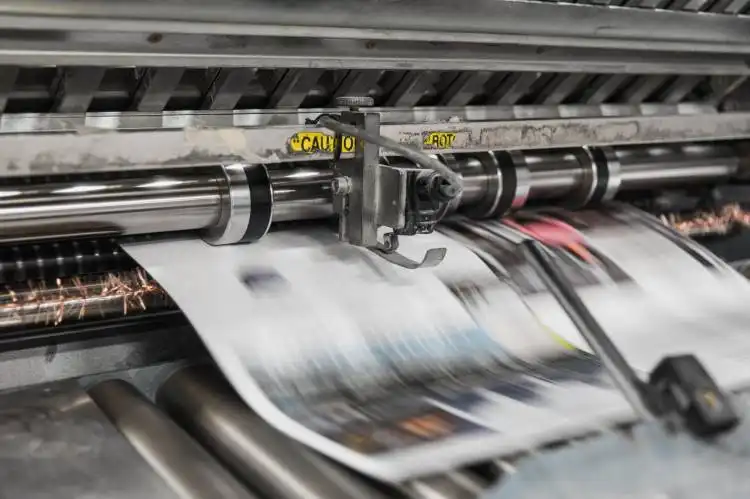Start a Used Book Store
Embark on the Grand Adventure of Building a Nostalgic Literary Haven
| Updated


USED BOOK STORE
Buckle up, bookworms, for a business idea that's bound to ignite your entrepreneurial spirit - a used bookstore! No, we’re not reading between the lines, it’s just as it sounds. Unlike a typical bookstore that sells new books, a used bookstore offers pre-loved tomes, each with its unique history, at a fraction of the cost of new books. This business is not just about selling affordable reads but also creating a hub for literature lovers, where each dusty spine whisks them away on a whole new adventure!
Jump to Business Plan
RELATED BUSINESS IDEAS
Browse ALL Retail & Shopping Business Ideas
Discover Your Perfect Domain
Unlock the door to your online success with our hand-picked selection of premium domain names. Whether you're starting a new venture or rebranding an existing one, the right domain can set the tone for your digital presence. Browse through our curated list, each with its unique potential to enhance your brand's visibility and credibility.
USED BOOK STORE MINI BUSINESS PLAN
This a quick reality check to help you identify the strengths and weaknesses of your business concept before you dive in.
Expected Margins:
- Gross Margin: 50-60%.
- This is based on the average margins for used bookstores. The actual figure depends on the buying and selling prices of the books.
- Net Profit Margin: 10-20%.
- This figure takes into consideration all operating costs, including rent, salaries, utilities, and additional costs.
Expected Earnings:
- Daily Earnings: $100 - $300.
- Depends on the size of the bookstore and the average price of books.
- Weekly Earnings: $700 - $2100.
- Simply the daily earnings multiplied by the number of operating days.
- Monthly Earnings: $3,000 - $9,000.
- Assuming 4 weeks in a month.
- Annual Earnings: $36,000 - $108,000.
- Assuming the bookstore operates all year round.
Actions to Achieve These Numbers:
Stock Procurement:
- Buy Used Books: This will be your primary source of inventory. Attend auctions, estate sales, and comb through classified ads.
- Book Donations: This is another good way to add to your stock. You can also organize book donation drives within your area.
Marketing and Customer Acquisition:
- Social Media: Regularly post images of newly added books on Instagram and Facebook. Post about 3-4 times a week.
- Local Advertisements: Ensure you're present in local directories and advertise in local newspapers. Consider budgeting at least $300 per month for this.
- Sales Promotions: Regular discounts or deals like "Buy 2, Get 1 Free" can attract customers.
Business Operations:
- Operating Hours: Try to open at least six days a week for eight hours a day to maximize customer exposure.
- Transaction Volume: Aim for around 10 to 20 transactions per day with an average sale price of $10-$15.
Remember, these are generalized estimates. Actual figures can vary, and it's best to do a detailed financial breakdown before starting your business.
NOT WHAT YOU HAD IN MIND? Here are more ideas



Browse ALL Retail & Shopping Business Ideas
Grab Your Business Website Name
Before you get caught up in the whirlwind of setting up your business, invest in a domain name. It's a small but significant step that lays the foundation for your brand and makes it easier for customers to find and trust you. Just like you wouldn't build a house without securing the land first, don't build a business without securing your domain name.
"Why? Can't that wait?" Here's why it shouldn't
Step 1: Determine if the Business is Right for You
Breakdown of Startup Expenses
Before starting a used book store, it is important to determine the startup expenses associated with the endeavor. This includes the cost of renting a space, purchasing shelves and other furniture, buying the books, and any other costs associated with setting up the store. Additionally, it is important to consider the cost of marketing and advertising to ensure the store is able to attract customers. It is also important to consider the cost of any licenses or permits that may be required.
Breakdown of Ongoing Expenses
In addition to the startup costs, it is important to consider the ongoing expenses associated with running a used book store. This includes the cost of utilities, such as electricity and water, as well as the cost of any employees. It is also important to consider the cost of any supplies that may be necessary, such as paper and ink for printing receipts. Additionally, it is important to consider the cost of any insurance that may be necessary.
Examples of Ways to Make Money
There are several ways to make money with a used book store. The most obvious way is to sell the books for a profit. Additionally, the store can also offer services such as bookbinding, book repairs, and book appraisals. The store can also offer special events such as book signings, author readings, and book clubs. Finally, the store can also offer other items such as book-related merchandise, stationary, and other items related to books.
Step 2: Name the Business
Choosing a name for your used book store is an important step in the process. It should be something that is memorable and easy to spell. It should also be something that reflects the type of business you are running. Consider using words that evoke a feeling of nostalgia or a connection to books, such as “Book Nook” or “Book Haven”. You should also consider using a play on words, such as “Booked Solid” or “Bookworm’s Paradise”. Additionally, you should make sure the name is not already taken by another business. You can do this by searching online and checking with your local government to make sure the name is available. Once you have chosen a name, you should register it with the government and secure any necessary trademarks or copyrights. This will help protect your business from potential legal issues down the road.
Step 3: Secure Financing
Securing financing is an important step in starting a used book store. There are a few options available to entrepreneurs looking to finance their business. The most common option is to apply for a loan from a bank or other financial institution. This is a great option for those who have a good credit score and can provide the necessary documents to prove their ability to repay the loan. Another option is to seek out investors who are willing to provide the necessary capital to get the business off the ground. This can be a great option for those who don’t have the credit score or the necessary documents to secure a loan. Finally, entrepreneurs can look into crowdfunding platforms to raise the necessary capital. This can be a great option for those who have a great idea but don’t have the necessary funds to get started.
Establish a Budget
Once financing is secured, it’s important to establish a budget. This will help entrepreneurs keep track of their expenses and ensure that they are staying within their means. Start by creating a list of all the necessary expenses such as rent, utilities, inventory, and payroll. Once the list is compiled, create a budget that outlines how much money will be spent on each item. This will help entrepreneurs stay on track and ensure that they are not overspending. Additionally, entrepreneurs should create a contingency fund in case of any unexpected expenses. This will help ensure that the business is prepared for any unexpected costs.
Step 4: Create a Business Plan
Creating a business plan is an important step in starting a used book store. It should include a detailed description of the business, including the services it will offer, the target market, and the competitive advantages it will have. It should also include a financial plan, which should include an estimate of startup costs, ongoing costs, and projected income. Additionally, the business plan should include a marketing plan that outlines how the business will reach its target market.
Benefits of a Business Plan
Having a business plan is essential for any business, and a used book store is no exception. A business plan can help the business owner to stay organized and focused on the goals of the business. It can also be used to secure financing from investors or lenders. Additionally, having a business plan can help the business owner to anticipate and plan for potential risks and challenges. Finally, a business plan can be used to measure the success of the business, as it provides a roadmap for the business to follow.
Step 5: Choose a Location
When choosing a location for a used book store, it is important to consider several factors. First, the location should be easily accessible to customers. This could mean being close to public transportation or in a high-traffic area. Second, the location should be large enough to house the inventory and provide a comfortable shopping experience. Third, the rent should be affordable and the lease should be flexible. Finally, the location should have the necessary permits and licenses to operate a business.
Researching the Area
Before choosing a location, it is important to research the area. This can include looking at the demographics of the area, the competition, and the local economy. It is also important to research the local laws and regulations to ensure that the business is in compliance. Additionally, it is important to research the local zoning laws to make sure that the business is allowed to operate in that area.
Signing a Lease
Once the ideal location has been identified, it is time to sign a lease. It is important to read the lease carefully and to negotiate the terms if necessary. It is also important to understand the landlord's expectations and to make sure that the business is in compliance with all local laws. Additionally, it is important to make sure that the lease includes a clause that allows the business to terminate the lease if necessary.
Step 6: Obtain Licenses and Permits
Before opening a used book store, it is important to obtain the necessary licenses and permits. Depending on the location of the business, there may be different types of licenses and permits that need to be obtained. For example, a business license, a sales tax permit, and a zoning permit may be required. It is important to research the specific licenses and permits that are required for the business.
How to Obtain Licenses and Permits
Once the types of licenses and permits have been determined, the next step is to obtain them. This can be done by visiting the local government office or website. The business owner will need to fill out the necessary paperwork and submit it to the local government office. The business owner will also need to pay any fees associated with obtaining the licenses and permits.
Benefits of Obtaining Licenses and Permits
Obtaining the necessary licenses and permits is important for any business. It ensures that the business is operating legally and is in compliance with local laws and regulations. It also helps to protect the business from any potential legal issues that may arise in the future. Additionally, having the necessary licenses and permits can help to build credibility with customers and other businesses.
Conclusion
In conclusion, obtaining the necessary licenses and permits is an important step in starting a used book store. It is important to research the types of licenses and permits that are required for the business and to obtain them before opening the store. Having the necessary licenses and permits can help to protect the business from any potential legal issues and can help to build credibility with customers and other businesses.
Step 7: Set Up the Store
Step 7: Set Up the Store - Furniture and Fixtures When setting up the store, it is important to consider the furniture and fixtures that will be needed. Depending on the size of the store, display cases, tables, and shelves may be necessary. It is also important to consider the aesthetic of the store, as the furniture and fixtures should reflect the overall theme of the store. For example, if the store is going for a vintage look, then antique furniture and fixtures should be chosen. If the store is going for a modern look, then modern furniture and fixtures should be chosen. Additionally, it is important to consider the cost of the furniture and fixtures, as this can be a large expense.
Step 7: Set Up the Store - Inventory The inventory of the store is the most important part of the setup process. It is important to research the types of books that will be sold in the store, as well as the prices that can be charged for them. It is also important to consider the condition of the books, as well as any special features that may be included. Additionally, it is important to research the best places to buy books in bulk, as this can help to save money on the overall inventory costs. Finally, it is important to consider the cost of shipping and handling for the books, as this can add up quickly.
Step 8: Market the Store
Step 8: Market the Store. Once the store is up and running, it is important to market it to the public. There are both online and offline marketing strategies that can be used to get the word out about the store.
Online Marketing Strategies. Online marketing strategies can include creating a website for the store, creating social media accounts, and utilizing search engine optimization (SEO) techniques. A website should include information about the store, such as its location, hours, and the types of books it carries. Social media accounts can be used to post updates about new books, sales, and other events. SEO techniques can be used to ensure that the store is easily found when people search for used books in the area.
Offline Marketing Strategies. Offline marketing strategies can include distributing flyers, using word of mouth, and advertising in local newspapers and magazines. Flyers can be distributed in the local area to let people know about the store. Word of mouth can be used to spread the word about the store. Advertising in local newspapers and magazines can also be used to reach a wider audience. Additionally, partnering with local schools, libraries, and other organizations can help to get the word out about the store.
Step 9: Manage the Store
The final step in starting a used book store is to manage the store. This includes managing the store's finances, inventory, and customer service. It is important to have a system in place to track sales, expenses, and profits. This will help you stay organized and ensure that the store is profitable. Additionally, it is important to have a system for tracking inventory. This will help you keep track of what books are in stock and what books need to be ordered. Finally, customer service is key to running a successful business. Make sure to provide excellent customer service to ensure that customers come back and recommend your store to others.
Hiring Employees
If you decide to hire employees, it is important to have a clear job description and expectations for each employee. Additionally, it is important to have a system in place to train and manage employees. This includes providing feedback and setting goals. It is also important to have a system in place to handle customer complaints and disputes. This will help ensure that customers have a positive experience when they visit your store.
Promoting the Store
Once you have the store up and running, it is important to promote it. This includes creating a website and social media accounts. Additionally, you can advertise in local newspapers and magazines. You can also reach out to local schools and libraries to let them know about your store. Finally, you can host events at the store and offer discounts and promotions to attract customers.
EXPLORE MORE CATEGORIES
Browse ALL Business Idea Categories
TAKE THE NEXT STEPS










